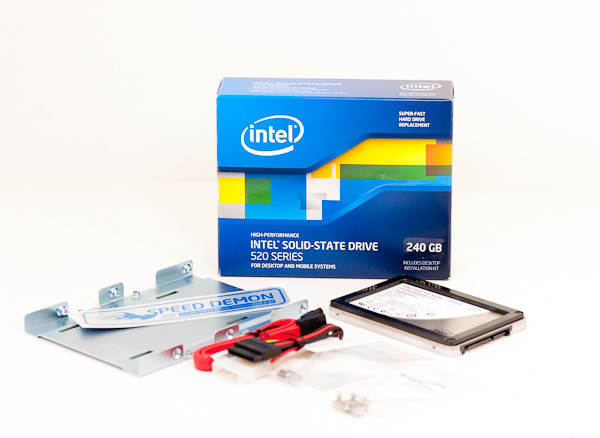Intel SSD 520 Review: Cherryville Brings Reliability to SandForce
by Anand Lal Shimpi on February 6, 2012 11:00 AM ESTFinal Words
I've been a fan of SandForce's technology since it first showed up in OCZ's Vertex 2 Pro in late 2009. Performance has never been an issue with SandForce and because of the fact that the controller writes less than its competitors, the controller and drives based on it are well behaved over months of use. The biggest issue with SandForce has always been a lack of validation compared to other, bigger players like Intel and Samsung. SandForce relies on its partners to do a lot of the validation and testing that would normally be internalized at its competitors. Until now, SandForce hasn't really had a partner large enough to really throw a ton of resources at drive validation. Now that SandForce is under the LSI umbrella things may change, but until then we finally have a well validated SF-2281 drive: the Intel SSD 520.
I'm still curious to see if other bugs crop up but if Intel hasn't found anything else after twelve months of testing I'm willing to bet that either the SF-2281 is irreparably broken or the 520 is going to be a reliable SSD.
I only have one data point where the 520 behaves better than other SF-2281 based drives, but that alone is a perfect example of what you pay for with Intel. This is exactly what we've been waiting for. If you want the absolute fastest SSD on the market today, the Intel SSD 520 is the only drive to get. If you're put off by the price, Samsung's SSD 830 is an excellent alternative.
I'm going to save this next bit for a future article, but have a look at the 520's performance in our enterprise workloads compared to the Intel SSD 320:
| Enterprise SSD Performance | |||||
| Oracle Swingbench | MS SQL DailyUpdates | MS SQL WeeklyMaint | |||
| Intel SSD 320 300GB | 56.5 MB/s | 207.3 MB/s | 230.4 MB/s | ||
| Intel SSD 520 240GB | 67.2 MB/s | 376.7 MB/s | 418.1 MB/s | ||
The 320 is actually widely used in servers as it's very reliable and can last a good amount of time with the right amount of over-provisioning. The 520 just destroys it. The bigger benefit is that if you're dealing with a workload that's not already compressed, the 520 will guarantee you much better drive longevity than the 320 thanks to the fact that it's simply not writing as much data to NAND. If you're looking for an affordable way to get a ton of IOPS for your enterprise workloads, Cherryville may be your ticket...











138 Comments
View All Comments
iLLz - Monday, February 6, 2012 - link
There you go, being all logical and stuff.DanSmith - Tuesday, February 7, 2012 - link
+1kyuu - Monday, February 6, 2012 - link
So, Intel wants people to pay a huge price premium over drives with identical flash and an identical controller? For what? Some validation testing and a custom firmware? Despite the fact that they source their own flash giving them a price advantage over everyone except maybe Samsung? Please.Also, the 240GB is *more* than twice as expensive as as the 120GB? Why wouldn't you just buy two 120GB drives then? I doubt the performance difference is even worth noting, and once Intel's own new RST drivers come out that support passing the TRIM command to RAID arrays comes out, you can R0 them and get *better* performance than a single 240GB.
FunBunny2 - Tuesday, February 7, 2012 - link
*NOT* identical flash or controller. Anand spent much of the text explaining that.NitroWare - Wednesday, February 8, 2012 - link
Not sure if the PCB is completely custom or Intel just put their logo on a slightly modified circuit board - and then there is the Bill of Materials for the supporting components.Corsair have been claiming publicly they went with a custom PCB for their Force 3 and even put up oscilloscope eye diagrams to 'prove' that their signal integrity as superior to a generic reference PCB
Coup27 - Monday, February 6, 2012 - link
Anand, could you please update Bench with the 830 results? They appear to have been forgotten about adding into Bench.Narrlok - Tuesday, February 7, 2012 - link
I second this request. I was about to post about this as well since I wanted to compare the 830 with this drive.beginner99 - Monday, February 6, 2012 - link
Well it seems obvious especially also because of the delay that the general advice here is to not touch OCZ and especially Sandforce seems to be more than true. There obviously must be quite a lot of bugs in the sandforce firmware.But then the price premium? I don't see it. You can get a crucial m4 that preforms just as good and has a very good track record in terms of reliability. (ignoring this 5000 hr bug...but it doubt even intel would spot that)
While it is sure a fast and reliable drive, the m4 is too while costing much less. And the Samsung isn't bad either.
eman17j - Wednesday, February 8, 2012 - link
they fixed the 5000 hr bugeman17j - Wednesday, February 8, 2012 - link
Also the newer line ocz came out with uses the Indilix controller